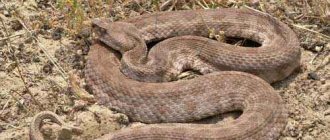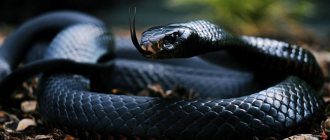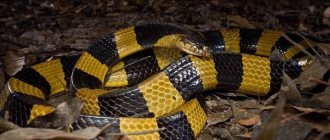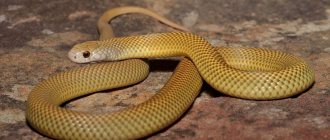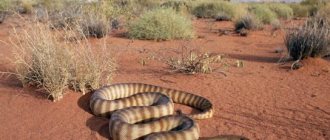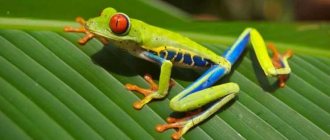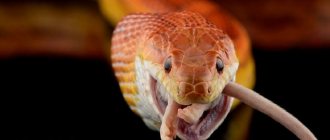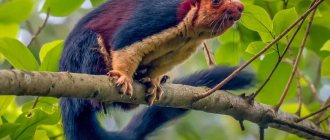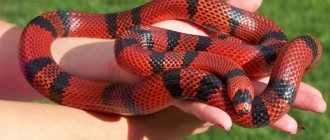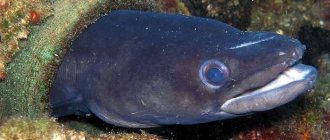We are accustomed to the fact that a snake has a small thickness and a length of up to one meter, but the longest snakes in the world reach truly gigantic sizes, and there are documented facts about this. The snake is a mysterious, fascinating animal and has always attracted human attention. In some cultures they are considered the embodiment of evil, while in others they are revered as a deity. As of 2022, there are 3,631 species of snakes in the world, some of them very long. Our rating is dedicated to these creeping creatures, the size of which is hard to believe.
Papuan olive python (Apodora papuana)
- Length: up to 4.4 m.
- Weight: up to 23 kg.
Based on the name, the main habitat of olive pythons is New Guinea. They have interesting skin that shifts between light and dark olive or brown shades depending on the lighting. Although the olive python's diet mainly consists of small mammals, it sometimes eats other snakes.
Contrary to popular belief, these reptiles are surprisingly gentle and docile, even when mistreated.
What is the name of the largest snake on the planet?
In some Internet sources, since 2010, there has been a message about the largest snake on the planet, which Egyptian biologists caught in the Red Sea. The name of the giant is Maga Maar Malad. Age – 103 years. Length – 30 m. Weight – several tons.
This message is a classic example of clickjacking. A scam in which the user is asked to go to a page to watch an amazing video. Before the video opens, the visitor needs to share it on social networks. Along with the browsing, malicious software gets onto the computer, giving the fraudster access to the computer and personal data, including accounts. Clicking the “Share” button sends the malicious file to the curious user’s friends.
By the way, for the first time information about the giant appeared on a bulletin board for students from Vietnam. Alas, giant snakes exist only in Hollywood cinema.
Reports of giant snakes appear in the press regularly. But it is difficult to estimate the size of a reptile from a distance. Therefore, people are sometimes mistaken, and sometimes they experience the hunter’s desire to show his best side and show off his gigantic prey.
Cuban boa (Chilabothrus angulifer)
- Length: up to 4.5 m.
- Weight: up to 27 kg.
Also known as the Cuban smooth-lipped boa. This snake is endangered. Cuban boas differ from other snakes in that they often hunt in groups. Cuban boas ambush bats in the openings of caves where they live in order to capture prey leaving the cave.
One of the reasons for the gradual extinction of the Cuban boa constrictor is the threat it poses to livestock. Therefore, farmers are clearing the area of these snakes.
Features of character and lifestyle
Photo: Extinct Titanoboa
Titanoboa led a secretive, solitary lifestyle. Their enormous size and physical strength were compensated by the fact that the snake was inactive on land, so it preferred to hide in the water. The snake spent most of its time buried in the mud and waiting for possible prey - a large fish that would not notice the hidden predator.
Like anacondas and boa constrictors, Titanoboa was designed to conserve energy. She moved only when she was hungry after digesting the previous food for a long time. She hunted mainly in water, but could swim close to land, hiding at the edge. When any animals of suitable size came to drink, Titanoboa would immediately react and kill them. The snake almost never crawled onto land, doing this only on rare occasions.
At the same time, Titanoboa was not overly aggressive. If the snake was full, it did not feel the desire to attack fish or animals, even if they were nearby. Titanoboa could also be prone to cannibalism, which confirms its solitary lifestyle. There is a possibility that these snakes were purely territorial creatures. They could defend their territory against other titanoboans, since the food supplies of these snakes were limited due to their size.
Imperial Boa (Boa constrictor)
- Length: up to 5 m.
- Weight: up to 45 kg.
This huge snake has distinct, saddle-shaped markings on its back and can have many different markings on its head. It lives in the forests and plains of Central and South America.
Boas have a large number of sharp, backward-curved teeth that are ideal for capturing prey. After capturing prey, the snake wraps itself tightly around its victim and contracts until it suffocates.
The emperor boa has small claws known as pelvic spurs, which are actually thought to be evolutionary remnants of what were once hind legs.
10. Levant viper or viper Length 2 m
The Levantine viper opens the top ten longest snakes on the planet . Its size and appearance are more familiar to our nerves, since it usually has a length of 1.9-2 m and weighs up to 3 kg. Although it has the very last place in the TOP 10, the toxicity of the viper's venom is second only to cobra. It has a calm brown color with a dark pattern on the back, and differs from other members of the family by sharp scales on the head. The Levant viper loves arid climates and areas without vegetation; it is common in Transcaucasia, Africa and Asia.
Paraguayan anaconda (Eunectes notaeus)
- Length: 4.8 m.
- Weight: up to 55 kg.
Location: South America
This strikingly bright reptile lives mainly in swamps and on the banks of rivers in South America. Even the mating process in individuals occurs in water. When anacondas venture into the forest, they usually hunt large game such as deer and peccaries (pig-like artiodactyl mammals).
Female Paraguayan anacondas tend to be larger than males and incubate their eggs internally to give birth to live young.
Indian python (Python molurus)
- Length: up to 6.5 m.
- Weight: up to 91 kg.
Particularly common in India, Sri Lanka and the East Indies, this impressive python often grows to a larger size in Indian jungles than in other areas. The Indian python's habitat varies greatly, including everything from grasslands and foothills to forests and swamps.
Unfortunately, these huge snakes are being hunted to death due to their beautiful skin. Excessive decline in their population threatens to disrupt the ecosystems in which they live.
Reproduction and care of offspring in large breeds of snakes
The majority of snake species reproduce by laying eggs, but there are ovoviviparous and viviparous species.
Amethyst python (Morelia amethistina)
- Length: up to 8.5 m.
- Weight: up to 91 kg.
In addition to its primary habitat of Australia, the beautiful amethyst python is found in New Guinea. This impressive snake is known for its reclusive nature. She gets very irritated when bothered. She gets her name from the striking blue shimmer that her skin produces in certain lighting.
Smaller individuals of the amethyst python live in trees and on hills, while larger individuals often choose rivers and other bodies of water to live.
Black Mamba
This poisonous snake is found on the African continent, choosing open forests and savannas for its life. Almost all the time it is on the ground, but occasionally it can be seen on trees, where they bask in the sun.
The average statistical indicators correspond to a body length of no more than 3 meters, with a mass of about 2 kilograms, although there are individuals weighing 3 kilograms, with a body length of more than 4 meters.
The black mamba has the longest poisonous teeth, reaching 2 and a half centimeters in length, when compared with its relatives, representing the asp family.
The diet consists of bats, elephant leapers, hyraxes, rodents, birds, as well as other types of snakes.
Interesting fact! Compared to some other snake species, the black mamba prefers to hunt during the daytime. She injects poison into her victim and then swallows it. Food is digested within a day, or even more.
African hieroglyphic python (Python sebae)
- Length: up to 7.5 m.
- Weight: 114 kg.
It is believed to be the largest snake species in Africa. This impressive reptile is most active during the wet seasons and often hibernates when the weather is dry. It has a grim reputation due to its intimidating size, especially since there are several reports of attacks on people.
Female African hieroglyph pythons can lay up to 100 eggs and are quite aggressive in protecting their brood.
Tell your amazing story
GET 500 rubles
Who is Titanoboa: truth or myth
About 60 million years ago, trees were much larger and taller than those that surround us today. This also applies to snakes. Some of them were larger than a school bus. In those distant times, the top of the snake kingdom was occupied by the ancestor of the modern boa constrictor - Titanoboa. This creature was gigantic in size. Its length could reach 15 meters. The monster's body weight was 1300 kilograms. Of course, this is hard to believe. But it's true.
“Even in our wildest dreams we could not imagine that we would find a 14-meter boa constrictor. The largest modern snake is half its size."
Carlos Jaramillo (one of the authors of the discovery), a specialist at the Smithsonian Tropical Research Institute
Now it’s hard to believe that Titanoboa existed.
It turns out that such a rapid growth of giant creatures was provoked by a large amount of food and the absence of enemies.
In addition, the average annual temperature reached +30 degrees. The ancient remains of the snake were discovered by an international team of scientists led by Jonathan Blog. They were found in the Cerejon coal mine in Colombia. Based on the structure of the creature's teeth, scientists determined that it ate fish. The good news is that the heyday of the creeping titans is long behind us.
Reticulated python (Python reticulatus)
- Length: up to 10 m.
- Weight: up to 159 kg.
This is a non-venomous snake native to Southeast Asia.
These reptiles kill their prey by ambushing and constricting them. Like many other large snakes, reticulated pythons have a very low metabolic rate and can take a long time to digest their prey.
They are predominantly nocturnal, often retiring into caves or crevices to wait out daylight.
Dusky tiger python (Python bivittatus)
- Length: up to 5.7 m.
- Weight: 183 kg.
This massive member of the python family is very active and is known to change habitats during its life. It lives in the same way as the reticulated python in Southeast Asia. Young tiger pythons spend most of their time hiding in trees. However, when they grow and become too large and heavy, they move to land or water.
Burmese pythons are non-venomous, which contributes to their popularity among exotic pet lovers.
Bushmaster, up to 3 m
The bushmaster (surukuku) is the largest representative of venomous snakes found in South America. Not many manage to see them; individuals prefer areas far from people’s homes; they do not form groups and live alone.
Their raised scales have a yellow-brown tint, against which there are large dark brown diamond-shaped spots. The standard length of a snake is 2.5-3 m, weight is from 3 to 5 kg, but sometimes individuals are found with a length approaching 4 m.
Individuals of this species prefer forest areas in the tropical zone; for them, a prerequisite for a comfortable existence is the presence of water. The bushmaster goes in search of food only after sunset; during the day he hides in impenetrable thickets. They feed on rodents, birds, and amphibians; the snake, covered with leaves, waits on the ground for its victims. Bushmaster venom is dangerous, with a mortality rate of up to 12%.
Green anaconda (Eunectes murinus)
- Length: up to 9 m.
- Weight: up to 250 kg.
The green anaconda is the largest snake in the world by mass. This amazing snake is also one of the longest in the world and can reach up to 30 centimeters in diameter! These magnificent snakes hold a special place in South American mythology, often depicted as magical creatures with healing powers.
Thanks to Hollywood, most people believe that anacondas hunt humans. Actually this is not true. The green anaconda's diet includes deer, tapirs, caimans, crocodiles, fish and turtles.
Many local legends and tall tales claim that the green anaconda can reach a staggering 12-18 meters in length, however these claims remain unverified and are likely exaggerated.
In fact, the fear of snakes is somewhat exaggerated, and photos of the largest snakes in the world are proof of this. Most of them are not able to cope with humans, and some are completely non-poisonous. Nevertheless, the stories of jungle tribes about aggressive snakes inspire writers and screenwriters to create various kinds of works about cannibal monsters. But this is more of a fantasy.
King Cobra
She is also a hamadryad. Being the largest among all venomous snakes, the king cobra is inferior in the strength of its venom to many other representatives of the snake world. The longest individual, more than 5.5 meters, lived in the London Zoo, where it was brought from Malaysia. The average length of king cobras is usually within 3-4 meters. The weight of an adult can reach 6 kg, and particularly large individuals can weigh up to 12 kg. Hamadryads live in the south and southeast of Asia, choosing wooded areas. They often creep up to residential buildings. The king cobra hunts during the day. It is noteworthy that it feeds on its own kind, without making concessions even to its poisonous relatives.
